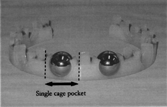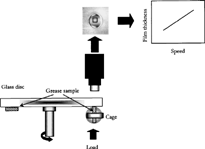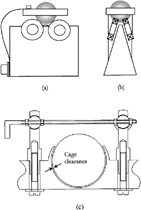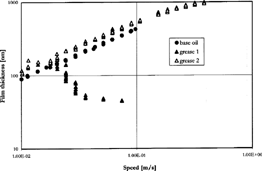Abstract
The effect of the cage clearance on the lubricant supply and elastohydrodynamic (EHL) film thickness has been studied in a ball-on-disc device. A single pocket from a standard nylon cage was mounted around the ball. The cage was instrumented so that the clearance between the cage and ball could be altered. Film thickness measurements were made with and without the cage present and for different clearances. Two lubricants were tested: a lithium hydroxystearate grease and its base oil. Film thickness was measured with increasing speed to determine the onset of lubricant starvation. Without a cage present the grease lubricated contact starved at a very low speed, typically 0.02 m/s and the film thickness dropped to a fraction of the fully flooded value. Starvation did not occur within the speed range for the base oil.
The presence of the cage significantly changed the starvation response. For the base oil reducing the clearance induced starvation by locally removing the lubricant from the track. The grease gave a very different result as reducing cage clearance increased the starvation speed thus ensuring fully flooded behavior over a much greater speed range. The improvement in grease performance with the cage present is attributed to two effects. First, the cage with reduced clearance helps to redistribute the grease into the track. Second, the close conformity between cage and ball promotes shear degradation of the grease structure generating low-viscosity material, which improves replenishment.
GREASE LUBRICATION OF ROLLING ELEMENT BEARINGS
Bearing failure can be costly and is often due to inadequate or inappropriate lubrication. There might be many different reasons for this; for example, operation at very low or high temperatures or excessive speeds. However, the underlying cause is the same and it is the inability of the lubricant to form a film sufficient to separate the moving surfaces. The operational film thickness is therefore an important parameter in determining bearing life, as it will affect both surface damage and fatigue (Zaretsky (Citation1)).
There have been many published studies of grease film thickness both in bearing tests (Wilson (Citation2); Williamson and Miller (Citation3)) and laboratory machines (Palacios, et al. (Citation4); Wedeven (Citation5); Rastegar and Winer (Citation6); Aström, et al. (Citation7); Cann (Citation8)). One conclusion from both types of tests is that the most important parameter determining grease film thickness is the inlet supply condition. Grease has a yield stress, and once it has been pushed aside by the passage of the rolling element, it will not readily flow back to replenish the track. Reflow, both on the free surfaces and around the ball, is surface tension driven and is retarded by the lubricant viscosity (Chiu (Citation9); Jacob, et al. (Citation10)). If the time interval between over-rollings is too short, replenishment will be incomplete. This can result in starvation of the contact and a severe reduction in film thickness (Cann (Citation8)). Earlier workers have shown that grease film thickness in bearings is often less than the base oil, suggesting that starvation does occur (Wilson (Citation2)). Starvation occurs most readily at low temperatures, high rotational speeds, or high-aspect ratio contacts and is an important cause of lubricant-related failure in many bearing systems (Cann and Lubrecht (Citation11)).
EHL film formation and the effect of inlet supply have been measured in laboratory test machines (Wedeven (Citation5); Aström, et al. (Citation7); Cann (Citation8)). Usually a ball-on-flat test device is used to simulate the ball bearing raceway contact. The influence of lubricant properties (thickener type, base oil properties) and contact conditions (speed, temperature, inlet supply) has been studied. One limitation of this approach is that the influence of bearing design and operating parameters on film thickness has for the most part been ignored. The laboratory-based tests have shown that inlet starvation will occur at speeds far lower than those commonly found in practice (Cann (Citation8)). However, as most bearings do seem to function efficiently over long periods it would suggest that the bearing is able to maintain lubricant flow into the inlet and that in this case an additional re-supply mechanism operates. This might be due to ball spin carrying displaced grease back into the rolling track (Zhu and Neng (Citation12)), vibration, or stop-start operation (Cann and Lubrecht (Citation11)). One important aspect that has been ignored so far is the influence of the cage on grease lubrication of rolling elements/raceways.
The primary role of the cage is to act as a separator for the rolling elements (a typical example is shown in ). There are many papers where the cage dynamics (Meeks (Citation13)) or lubrication of the cage pocket/ball bearing (Molina and Gohor (Citation14)) have been considered. However, there is very little published information on the role of the cage in regulating the grease supply to the contact.
The earlier ball-on-disc studies have shown that unless the grease supply to the inlet is maintained, the contact will progressively starve as the speed increases (Cann (Citation8)). Thus the onset of starvation is dependent on the speed and grease properties. Film thickness in the starved regime will often decay with time (over-rollings) to less than the fully flooded value (Cann (Citation8); Hurley and Cann (Citation15)). However, in some cases, the film is observed to decay and then recover (Hurley and Cann (Citation15)). This reflects the increasing availability of low-viscosity material close to the contact (Mérieux, et al. (Citation16)), due to working of the grease during over-rolling. The ability of grease to form a lubricant film will be determined by the starvation speed (us), and for speeds exceeding us the film thickness becomes time dependent. Thus, the onset of starvation and possible failure of a bearing is determined by a complex set of variables relating to bearing design and operation, and lubricant properties. The use of classical fully flooded EHL film calculations is likely to overestimate the film thickness found in practice. To assess the suitability of grease for a given application it would be necessary to determine whether starvation is occurring and, if so, whether he is an adequate thickness. Lambda values (the ratio of the film thickness and the standard deviation of the asperities) of 0.8-2 have been quoted for normally operating bearings (Williamson and Miller (Citation3)). The time to achieve the equilibrium is also important as reactive additives might be required to protect the surfaces before the film is established.
The question addressed in this study was, Does the presence of a cage affect the lubrication performance, particularly the onset of starvation and the equilibrium film thickness in the starved regime? What is the mechanism of this effect, and how is it influenced by cage clearance?
EXPERIMENTAL
Test Device
A ball-on-flat test device was used to simulate the bearing contact (). The film thickness in the center of the contact was measured by thin film optical interferometry (Johnston, et al. (Citation17)). The test device and the application of the thin film method to grease studies have been described in earlier publications (Cann (Citation8)). The nylon cage was of standard design from a commercial bearing (ball diameter 14.2 mm). Individual pockets were cut from the cage () and mounted around the ball; see . A small screw device was constructed and mounted on the open face of the cage; see . Thus, the ball-cage clearance could be increased or decreased; see in a controlled manner by rotation of the screw. The test conditions are summarized in .
TABLE 1 EHL Test Conditions
Before each test the glass disc and ball were solvent cleaned and assembled. The microscope was focused into the center of the contact and the zero position film thickness was measured. For the base oil tests 2-3 mL of oil was then pipetted onto the underside of the disc and onto the ball. This volume of oil was more than sufficient to ensure fully flooded conditions over the speed range (see ).
For the grease tests the disc was rotated at 0.005 m/s and the sample (0.1 g) applied to the rolling track. Once the grease was positioned around the track the rig was run for a further 10 minutes to ensure an even distribution. The test was carried out by slowly increasing the speed while measuring the film thickness in the center of the contact. The onset of starvation was identified by a change in the shape of the image on the screen and a drop in the film thickness. From this point onward the results were usually time dependent, as it takes a number of revolutions for the film thickness to equilibrate. Therefore, at each step change the speed was held constant until the film thickness had stabilized. Once stabilization had been achieved the speed was increased again. Each test was run twice.
In order to establish reference curves it was necessary to run tests without a cage present. This was simple for the base oil; however, for the grease two procedures were used. In order to establish a fully flooded curve for the grease over the speed range it was necessary to use an external mechanism to replenish the lubricant in the inlet. A plastic scoop was positioned under the rolled track and pressed up against the underside of the glass disc. This collected the displaced grease and pushed it back into the track, thus maintaining the lubricant supply. Tests were also run without the scoop present to establish the normal starvation speed of the grease (see ).
Test Lubricants
In order to eliminate the influence of additive packages two simple lubricants were used: a model lithium hydroxystearate grease (15% w/w thickener, mineral base oil) and its base oil. The base oil had a viscosity of 200 cSt at 40°C.
RESULTS
Film thickness results are shown in . In film thickness is plotted as a function of speed for the base oil and grease with no cage present. The base oil shows a classical EHL curve with a log-log gradient of 0.67. Starvation was not observed over the speed range. The grease gave a very different speed response. The Grease 1 curve was measured without a grease scoop and in this case starvation started at 0.02 m/s. This is a typical response of grease without the use of an external mechanism promoting redistribution. In order to maintain fully flooded conditions throughout the speed range it is necessary to continuously force the grease back into the track. The effect of this is seen in the Grease 2 curve where the scoop was used. The fully flooded grease film thickness typically exceeds the base oil value by 10% due to the presence of the thickener. Without a mechanism to replenish the track the grease contact starves and the film thickness drops to a very low level. Thus, even at fairly modest speeds (0.1 m/s) the film thickness is less than 10% of the fully flooded level.
FIG. 5 Film thickness results for the base oil with the cage present. Four different clearances (0.5 mm, 0.35, 0.2 mm, 0.05 mm) and fully flooded (line).
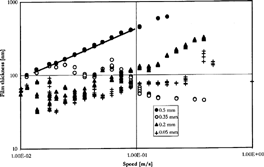
FIG. 6 Film thickness results for the grease with the cage present. Four different clearances (0.5 mm, 0.35, 0.2 mm, 0.05 mm) and fully flooded (line).
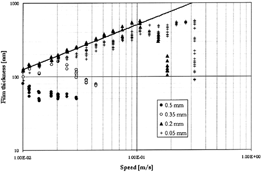
Film thickness results with the cage present are shown in . The results for the base oil are plotted in . This figure shows the fully flooded base oil curve and the effect of cage clearances of 0.5 mm, 0.35 mm, 0.2 mm, and 0.05 mm. The 0.5 mm clearance had little effect over the speed range considered. The clearance of 0.35 mm induced starvation for speeds above 0.2 m/s. Finally, the clearances of 0.2 and 0.05 mm gave starvation speeds of 0.08-0.1 m/s. In some tests the film thickness was found to increase again at high speeds; this was probably due to vibration of the cage helping to transfer oil back into the rolled track. However, the results clearly show that reducing the clearance on the cage induces starvation at increasingly lower speeds.
The corresponding results for the grease are shown in . A complete inversion of the base oil trend is obtained. The smallest clearance gave the highest starvation speed, whereas the largest clearance gave results similar to the condition with no cage present.
DISCUSSION—GREASE LUBRICATION MECHANISMS
The results have shown that the cage has a profound influence on film thickness for both grease and base oil. Two opposing trends were observed in the test. Base oil starvation could be induced by the presence of the cage and reducing the cage clearance aggravates this. Reducing the cage clearance in the case of grease lubrication significantly improves replenishment and increased the starvation speed.
These observations can be explained by considering the effect of the cage on the local distribution of lubricant on the ball track. For the base oil case, the cage acts mainly as a scraper limiting the amount of oil entering the inlet region. Reducing the clearance exacerbates the effect.
The opposing trend is seen with the grease. Reducing the clearance helps to push grease back into the track. This ensures the presence of the lubricant in the inlet region and the resulting film thickness is close to fully flooded level over an extended speed range.
The cage also has a second effect; it locally shears the grease within the cage-ball contact and thereby produces mobile low-viscosity material, which increases replenishment. This material would be expected to flow more readily and thus aid the redistribution process. Earlier work (Mérieux, et al. (Citation16)) has shown the importance of shear degradation in promoting replenishment in grease-lubricated contacts. A word of caution, however: reducing the cage clearance to very small values can result in a domination of the scraping effect over the redistribution mechanism.
The work further exemplifies the complexity of grease lubrication and the different lubrication mechanisms that could occur under different operating conditions. The importance of cage-driven lubricant redistribution has still to be determined in real-life applications, although it is possible that it is the dominant mechanism for most conditions. Redistribution of the grease takes place at the cage/ball interface and it is probable that the efficiency of this process is determined by the grease rheological response to the high shear/low pressure conditions. There has been much activity recently in grease research aimed at developing a rheological test capable of predicting grease lubrication performance in bearings. The observations from this work offer for the first time a physical basis for the development of such a test.
The importance of the cage in determining lubrication level will depend critically on the operating conditions of the bearing and the properties of the grease. At low speeds and high temperatures where lubricant reflow occurs independently of cage action, the properties of the thickener system will determine friction and film thickness (Cann and Hurley (Citation18)). This is also the case for greases that have a low base oil viscosity or readily bleed base oil, as there will be plenty of low viscosity material available for reflow. Under these conditions, the lubrication performance will be determined by the properties of the base oil and the cage will not have an effect.
One final observation from this work concerns the further development of cage design. With conventional bearing tests it is difficult to unequivocally determine the effect of cage design on lubrication performance. Bearing tests are both expensive and time consuming and represent an extremely complex set of test variables. The procedure reported here offers a relatively simple and rapid method of directly assessing the effect of cage design on film thickness.
CONCLUSIONS
The role of the cage in determining the onset of starvation has been studied in a bearing simulation rig. The conclusions from this work are as follows:
| 1. | With grease lubrication, the presence of a cage can have a significant effect upon the film thickness. | ||||
| 2. | The onset of starvation is delayed until far higher speeds with the closely conforming cage. | ||||
| 3. | The cage appeared to work by redistributing the grease in the cage/ball contact. If this mechanism is critical for determining lubricant supply, and hence film thickness, then it might be possible to optimize grease rheological properties to exploit this effect. | ||||
| 4. | This experimental approach offers a method of quantifying the role of cage design on bearing lubrication. | ||||
Acknowledgments
Presented at the STLE/ASME Tribology Conference in Ponte Verda Beach, Florida October 27-29, 2003 Final manuscript approved July 5, 2003 Review led by Ted Bailey
REFERENCES
- Zaretsky , E. , ed. 1992 . STLE Life Factors for Rolling Bearings , STLE Publ. .
- Wilson , A. R. 1979 . “The Relative Thickness of Grease and Oil Films in Rolling Bearings” . Proc. IMechE , 193 : pp 185 – 191 .
- Williamson , B. R. and Miller , D. 1999 . “Condition Monitoring of Grease Lubricated Rolling Element Bearing” . NLGI Spokesman , 63 : pp 8 – 15 .
- Palacios , J. M. , Cameron , A. and Arizmendi , L. 1981 . “Film Thickness of Grease in Rolling Contacts” . ASLE Trans. , 24 : pp 474 – 478 .
- Wedeven , L. 1975 . University of London . PhD Thesis
- Rastegar , F. and Winer , W. O. 1986 . “On the Traction and Film Thickness Behaviour of Greases in Concentrated Contacts” . NLGI Spokesman , : pp 162 – 170 . August
- Åström , H. , Ostenson , J. O. and Höglund , E. 1993 . “Lubricating Grease Replenishment in an Elastohydrodynamic Point Contact” . ASME Jour. Trib. , 115 : pp 501 – 506 .
- Cann , P. M. 1996 . “Starvation and Reflow in a Grease Lubricated Elastohydrodynamic Contact” . Trib. Trans , 39 : pp 698 – 704 .
- Chiu , Y. P. 1974 . “An Analysis and Prediction of Lubricant Starvation in Following Contact Systems” . ASLE Trans. , 17 : pp 22 – 28 .
- Jacod , B. , Publier , F. , Cann , P. M. and Lubrecht , A. A. 1999 . “Track Replenishment in and out of Contact” . Proc. 25th Leeds-Lyon Symp. on Trib. , : pp 483 – 492 .
- Cann , P. M. and Lubrecht , A. A. 1999 . “Analysis of Grease Lubrication in Rolling Element Bearings” . Lubr. Science , 11 : pp 227 – 245 .
- Zhu , W. S. and Neng , Y. T. 1988 . “A Theoretical and Experimental Study of EHL Lubricated With Grease” . Jour. Trib. ASME Trans. , 110 : pp 38 – 43 .
- Meeks , C. 1984 . “The Dynamics of Ball Separators in Ball Bearings. Part 2” , ASLE Paper .
- Molina , M. A. and Gohar , R. 1978 . “Hydrodynamic Lubrication of Ball-Bearing Cage Pockets” . Jour. Mech. Eng. IMechE , 20 : pp 11 – 20 .
- Hurley , S. and Cann , P. M. 2000 . “Starved Lubrication of EHL Contacts—Relationship to Bulk Grease Properties” . NLGI Spokesman , 64 : pp 15 – 23 .
- Mérieux , J. S. , Hurley , S. , Lubrecht , A. A. and Cann , P. M. 2000 . “Shear-Degradation of Grease and Base Oil Availability in Starved EHL Lubrication” . Proc. 26th Leeds-Lyon Symp. on Trib. , : pp 581 – 588 .
- Johnston , G. J. , Wayte , R. W. and Spikes , H. A. 1991 . “The Measurement and Study of Very Thin Lubricant Films in Concentrated Contacts” . Trib. Trans. , 34 : pp 187 – 195 .
- Cann , P. M. and Hurley , S. 2002 . “Friction Properties of Grease in Elastohydrodynamic Lubrication” . NLGI Spokesman , 66 ( 6 ) : pp 11 – 15 .
